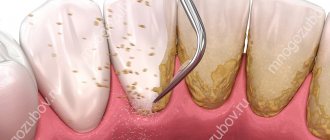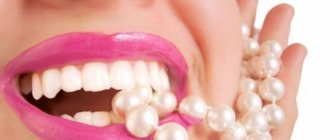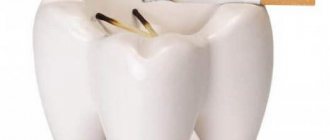Dental health is closely related to the health of your gums. If everything is fine with some, then the safest conditions in the oral cavity are created for others. However, with weakened, painful, often inflamed gums that are prone to bleeding and pain, serious dental problems can occur.
We often go to the dentist, get new fillings and treat dental caries, but we often forget about the health of our gums. They also need various preventive measures. First of all, care should be taken to strengthen them. We will tell you what safe methods can be used for this.
Don't forget to rinse after meals
Rinsing your teeth only during and after brushing is a big mistake. Any dentist will advise you to carry out this procedure more often, preferably after every meal.
Leftover food in the mouth can cause gum inflammation. Use plain water or special solutions.
Advice! It is especially important to rinse your mouth after eating sweets. Sugar can be the enemy of your teeth and gums. In just a few hours it creates a breeding ground for bacteria.
Gum recession: why gums recede
The formation of gum recession occurs when the surface of the tooth root is exposed. Without consulting a dentist, you will never be able to determine the exact reason why your gums are receding. This is due to a whole range of possible reasons, and in addition there are a large number of predisposing factors that make the risk of recessions more likely. Let's look at them.
1) Occlusal trauma, overload of teeth –
Occlusal trauma means that the contacts between your lower and upper teeth are not ideal, and in some areas there may be so-called “super contacts” (areas of premature overbiting). Normally, when the jaws are closed, the contact of the premolars, canines and molars should first occur, and only lastly the incisors. But if your incisors close first, then after all the other teeth have closed, they will experience overload, which will lead to bone resorption and a decrease in gum level (see photo below).
In addition to improper contact between the upper and lower teeth, bruxism (excessive uncontrolled clenching of the jaws, most often at night) can lead to occlusal injury. Patients usually refer to this condition as teeth grinding during sleep. You can learn more about this disease using the link above.
Exposure of tooth roots as a result of occlusal trauma:
Excessive chewing pressure on the teeth for a long time leads to resorption of the bone around them. Accordingly, in parallel with the decrease in bone level, there is also a decrease in the level of the gums, which primarily becomes noticeable in the area of the lower anterior teeth. For example, if you are missing part of your lateral chewing teeth, this leads to a redistribution of the chewing load on the remaining teeth, which will cause them to be overloaded. The front teeth are not physiologically designed for chewing at all - their function is to bite off food. In the absence of lateral chewing teeth, chewing food occurs with the front teeth, which quickly leads to their overload.
The absence of even 1 chewing tooth on each side can quickly lead to a decrease in the bite height in the lateral parts of the jaws, and this in turn will lead to excessive contact of the upper and lower front teeth (which will also cause bone resorption and gum recession with exposure of the roots of the teeth) . Moreover, a decrease in bite in the lateral parts of the jaws can occur not only due to the loss of several teeth. This can also occur due to excessive abrasion of dental tissues (on the chewing surfaces of molars), due to errors in prosthetics or restoration of teeth with filling materials, as well as as a result of the gradual abrasion of old fillings.
What to do - if you do not have missing teeth, then you need either a “gnathologist” or a very good orthopedic dentist to carry out “selective grinding of teeth” (this procedure will normalize the contacts between the upper and lower teeth, removing all “super contacts”) . If you have a reduced bite height in the chewing parts of the jaws due to the absence of some teeth, you need prosthetics. We are talking about replacing missing teeth with artificial crowns, replacing old fillings on the chewing surfaces of molars with ceramic inlays... But you need to start with a consultation with a prosthetist.
2) Chronic generalized periodontitis –
We have already said above that one of the main reasons why gums recede is their inflammation. It all starts with a completely harmless superficial inflammation of the gums (gingivitis), which is manifested by bleeding gums, their swelling and pain when brushing your teeth. But in the absence of treatment or improper treatment of gingivitis, the attachment of the gums to the neck of the teeth is gradually destroyed, inflammatory bone resorption and the formation of periodontal pockets begin to occur.
Reduced gum level due to gum inflammation –
When bone destruction reaches a certain degree, tooth mobility also joins the symptoms. Destruction of the periodontal attachment, bone resorption, periodontal pockets, tooth mobility - these are all symptoms of the next stage of gum inflammation, which is called periodontitis. Accordingly, because When periodontitis occurs, the level of bone tissue around the teeth decreases, and the level of the gums will also decrease.
Important: please note that a decrease in the level of gums in the area of 1-2 teeth is possible even with the most initial form of gum inflammation - even with catarrhal gingivitis. And for this it is enough simply to have microbial plaque in the area of the necks of the teeth (+ the presence of some predisposing factors, for example, a thin gum biotype). But with chronic generalized periodontitis, subsidence of the gum level occurs immediately in the area of a large group of teeth.
What to do - you need to start with a consultation with a periodontist (this is a dentist who specializes in the treatment of gum inflammation). Treatment of periodontitis includes not only anti-inflammatory therapy and removal of dental plaque, but also splinting of movable groups of teeth and prosthetic replacement of missing teeth. Therefore, in addition to consulting a periodontist, you may also need to consult an orthopedic dentist.
3) Incorrect movements of the toothbrush –
If you brush your teeth with a horizontal motion (instead of a sweeping motion) every day year after year, this can lead to gum recession - especially in the area of the lower front teeth. Typically, such patients not only have receding gums, but also hard tissue defects of non-carious origin appear in the area of the necks of the teeth. Incorrect brushing technique plays an important role in the formation of gum recession - especially in the presence of predisposing factors (thin gums, small height of attached gums, concomitant catarrhal gingivitis, etc.).
4) After correcting the bite with braces -
After correcting the bite with braces, you can often notice a decrease in the level of the gums. What I want to say here... There are only a few good orthodontists, so most of them plan orthodontic treatment without taking into account factors such as the height of the attached gum, the biotype of the gum, the thickness of the cortical plate of the jaw in the area of the teeth being moved. And as a result, we have what we have...
5) In the presence of predisposing factors –
Below we present a number of factors that sharply increase the risks of gum loss and root exposure. In some cases, they themselves can be the cause of gum recession (such as a highly attached frenulum of the lower lip), but most often they increase the damaging effects of the causes that we described above. These predisposing factors relate to the individual anatomical features of the gum structure in different patients.
- If you have a thin gum biotype, thin biotype means a small gum thickness. With the same force of the damaging factor, in patients with thin gums, recession will occur faster and be deeper than in patients with thick gums.
- Thickness of the cortical plate of the alveolus - if your cortical plate of the jaw (the front wall of the alveolus) is too thin.
Let's look at this using the example of the lower incisors. The anterior surfaces of the roots of the lower incisors are covered with a thin layer of bone, on top of which soft gum tissue is already located. In some patients, this layer of bone may be too thin (less than 0.5 mm), which, in the presence of a damaging factor, leads to too rapid bone loss, followed by a decrease in gum height. In some patients it can be even worse. For example, on the front surface of the roots of the lower incisors (in the area of their upper thirds) there may be no bone plate at all. In this case, the upper third of the roots will be covered only by the gum. This situation creates a risk of a recession, i.e. the fact that the gums will recede and the tooth root will be exposed - maximum.
- The height of attachment of the frenulum of the lips - for example, the frenulum of the lower lip may be attached too high to the gum edge, and then the movement of the lips (during conversation and facial expressions) will lead to the frenulum “tearing” the edge of the gum from the teeth. The same will apply to the low-attached frenulum of the upper lip.
- Insufficient level of attached gum – the gum is usually divided into “attached” and “unattached” (see photo below). Above the dotted line is the attached gum, and below it is the non-attached mobile gum. The peculiarity of the attached gum is that it is firmly fused with the underlying tissues and therefore immobile. The unattached gum is mobile, and its peculiarity is that it follows the movement of the lips and cheeks.
Very often the gum recedes on a tooth that has a very small height of attached gum. There is a clear relationship - the lower the level of attached gums, the higher the risk of recession (recession of the gums and exposed roots). When the level of attached gum is low, dentists often recommend performing special surgical operations on the gums, which can increase the level of attached gum and prevent exposure of the roots of the teeth.
Use antiseptics for prevention
Antiseptic solutions are not suitable for continuous use. They are usually prescribed for the treatment of dental diseases, after tooth extraction or other complex operations in the oral cavity.
In addition, antiseptics are recommended for inflammation and bleeding gums to prevent the proliferation and increased activity of bacteria.
What antiseptics can be used to rinse your mouth?
- Furacilin. It is usually sold in the form of yellow tablets that need to be dissolved in a glass of water. The solution has a slight salty taste, usually does not cause irritation and does not increase gum inflammation.
- Miramistin. At the pharmacy, this product can most often be found in the form of a bottle of liquid. The box may contain special attachments. Miramistin solution has virtually no pronounced taste and does not cause discomfort.
- Iodinol. Sold in glass bottles, dark in color. A few drops of the product are mixed with water to obtain a solution. This drug has a pronounced antiseptic effect and a slight unusual taste. May slightly increase gum irritation if inflammation is present.
- Chlorhexidine. Sold in plastic bottles. The solution based on this drug has a mild medicinal aftertaste. Inflammation usually does not increase after use.
Causes associated with dental diseases
The cause of loose teeth in the gums can be various dental diseases, such as periodontitis, periodontal disease, periodontitis and gingivitis. Incorrect bite can also trigger the appearance of this disease.
With gingivitis, many bacteria live in the oral cavity, which cause bleeding gums and, as a result, loosening of teeth.
With periodontitis, the same symptoms are present, but they are also accompanied by bad breath and inflammatory processes in the gums begin. The cause of both diseases is poor oral hygiene.
Periodontal disease is not associated with inflammatory processes and is accompanied by a decrease in the bone walls between all teeth, resulting in bleeding and itching in the gums, and the teeth become mobile and their sensitivity increases.
Fight bleeding gums
If the slightest mechanical impact causes pain and easily injures the gums, causing bleeding, then this cannot be considered a normal phenomenon.
First, you need to contact your dentist and find out the cause of bleeding and weak gums. Secondly, you need to use comprehensive methods to treat them and eliminate the problem.
Differences between periodontal disease and periodontitis
Patients often confuse the names, and therefore turn to dentists, complaining of periodontal disease. In 90-93% of cases, ordinary periodontitis is detected. It is widespread. Our disease is rare.
Periodontitis manifests itself through:
- pain on palpation, when brushing teeth;
- bleeding;
- redness of the gum margin;
- swelling;
- cyanosis.
In severely advanced cases, there may also be headaches, fever and severe toothache. All this leads to refusal of food and hygienic cleaning of the oral cavity.
By place of development:
- localized - a small lesion affecting only one tooth; often results from mechanical damage to tissue;
- generalized - damage to several teeth also affecting the gingival and bone tissue.
According to the nature of the course:
- acute - characterized by sudden pain attacks and rapid development of symptoms;
- chronic periodontitis is the transition of untreated acute periodontitis to a chronic form, in which pain and other symptoms practically disappear, but the disease progresses and deforms the tissue.
Massage your gums to improve blood circulation
Strengthening your gums is not just about using toothpastes and rinses. Gums need normalization of blood circulation. This requires a massage. It can be done using circular movements with your fingers or a soft toothbrush.
You can also find special brushes for gum massage on sale. By improving blood circulation, you can strengthen them over time and prevent many complications.










